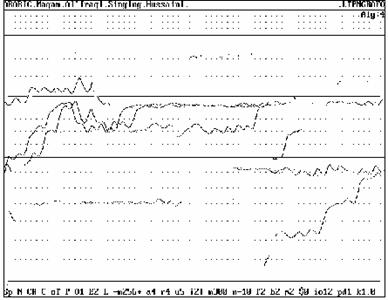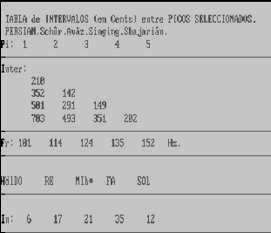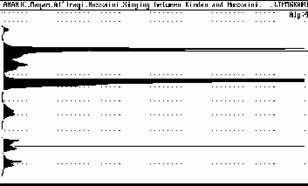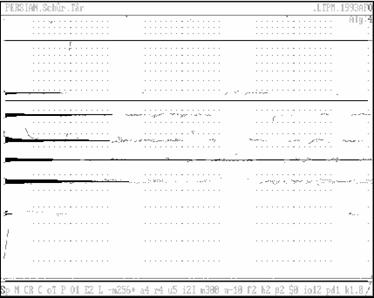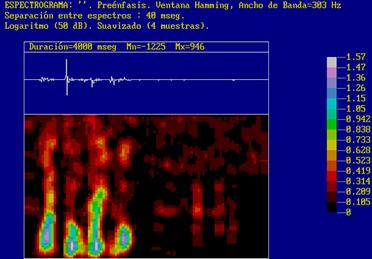ESCALA. Automatic Measurement of Oriental Scales.
ABSTRACT. Oriental (Arabic, Turkish, Persian, North Indian, Byzantine, Flamenco) music cannot be adequately represented in the Western tempered scale, as is well known. The automatic measurement of oriental scales of maqamat and similar musical forms is a complex process, according to the complexity that these musical forms present. Pitch, Note, Interval, Scale, Consonance Structure and Maqam are stages of this analysis, assisted by correlative models of these aspects; we are far from tempered semitone scale recognition. The program ESCALA executes all those tasks on recorded or actual sounding music, by means of personal algorithms of pitch estimation and pattern recognition methods. ESCALA permits an accurate real‑time measurement of pitch shades, with a careful notation in 53‑degree/octave Hölder commas, in 72‑degree/octave commas, or in almost exact Cents. Moreover, ESCALA can find the main consonances to estimate the modal tonic, and its related hierarchy. musical examples of those kinds of music, and their scale evaluation, will be presented during our talk, and our original pitch estimate methods will also be discussed. INTRODUCTION The so-called Oriental Music in the West, employs a very rich and complex set of tones (pitches) and rhythms that are constitutive elements in this music; the tempering or rounding off those pitches impoverishes and converts it into tasteless stuff. The mastering of those shades of pitch, and their use in actual music (maqam, dastgah, raga), are a matter of time (a lifetime) which few persons, in the West or in the East, are disposed to or have the possibility of dedicating to it. However, only the person who does so, receives the richness of a Music which find its roots in the Past and blooms in the Present [1, 9, 16, 17, 23, 31]. Music comprehension and enjoyment is a question of playing, communicating, receiving sounds and hidden meanings; but, from the musicological point of view, it is also very important to know the theory of the system and language involved in the music of a particular culture. The experts in the practice of this music (musicians, and some listeners) are able to pick up those shades of pitch, formerly described. But special conditions of listening and performance are needed, and no person can perceive all the shades in all the cultures: each listener always tries to understand a pitch as one of the elements of its own musical language (top of the list, the Western musicologist, who calls Do, Re, MI - c, d, e-, notes with other function, meaning and pitch). We should not forget that in traditional music the tone, the note, is made by and for the finger, the vocal string and air pressure of the performer, much more than in the Western Music, where tone is fixed in the ear of musicians and listeners, as in many musical instruments (piano, organ, vibraphone, electronic instruments). As a conclusion, we can assume that Oriental Traditional Music is much more aware of pitch than Western. The kind of music for which we intend our measuring tool to be useful, is primarily the cultured Oriental; in that wide concept we include: Arabic (A): Iraqi, Syrian, Egyptian; Turkish (T); Persian-Azeri (P); Andalusi-Mahghrebi (M); Byzantine (B); Oriental Christian (C): Armenian, Syrian, Maronite, Copt; Western Christian (G): Gregorian, Ambrosian, Roman, Beneventine; Indian (I): Pakistani, some Afghan; we include Spanish Flamenco or Cante Hondo (H) too; for a scale measurement alone we can work on any monodic music (Chinese, Japanese, Indochinese, Malayan, Javanese, etc.); and of course, all Folk (F) Music, which often sings free from the cultured framework. See [4-11, 14-23, 25-27, 29-30, 37, 39, 45-46, 48, 50]. To approach those various musical systems, a general code and a way to relate it to a specific music, are necessary, that is, a fine division of the octave, and a fine tool of measurement. This tool is valuable, not only to understand a particular kind of music, but also to know its tone system, establish its theory, and assist in its practice. This measurement must approach the perceived tone or pitch, rather than the fundamental frequency, a physical parameter not entirely proportional to it. MUSICAL CODE AND NOTATION We adopt a notation based on the division of the octave in 53 equal intervals; these intervals are called Hölder commas: they have therefore a size of 22.6 cents. With an error less that 1.2 cents, the major and minor Pythagorean and Natural (Zarlino) scales are represented by any of these 53 degrees; both scales will appear therefore with their usual names, c, d, e, (do, re, mi) etc. We take the Major Pythagorean as the basís of our notation [3, 7]. The deviations with respect to the Pythagorean Scale will be expressed by the usual symbols together with the deviations in commas, according to the following list: commas rising lowering 1 + ‑ 2 * = 5 b In this way we cover all the 53 degrees, in the tone intervals ( i.e., do-re): notes: do do+ do* reb‑ reb reb+ reb* re= re‑ re commas: 0 1 2 3 4 5 6 7 8 9 and the semitones (i.e., mi-fa): notes: mi mi+ fa= fa‑ fa commas: 0 1 2 3 4 the others 53 degrees being equally represented. Thus the Zarlino Natural Scale will appear with a '-' comma in E, A, and B, and any other scale will be represented by a degree of the 53‑set with a maximum error of 12 cents (half a comma); however the actual error is usually much less because 'natural scales' mainly uses consonances, and these are well represented by the Hölder set. For instance,
Arabic Mahur would be: C D E F G A B- C
Turkish Rast would be: C D E- F G A B- C
Egyptian Rast would be: C D E= F G A B= C
Egyptian Baiati would be: D Eb* F G A Bb C D
Persian Schur would be: D Eb+ F G Ab+ Bb C D
Nahauand would be: C D Eb F G Ab+ B C
Note the fine pitch shades that this notation embodies, as in note E, for instance. This notation is similar, but not identical, to those used by Danielou [6], and by Turkish Traditional Music [11, 30, 50]. The first, very accurate, is somewhat complex, because it take a Zarlino Scale as a basís, and employs major and minor tones, 4-comma flats, and a 1/4 interval, out of the comma status. The second adopts the Pythagorean Scale as its basís, but uses up till eight types of flats and sharps. We prefer our notation because we find it simple and intuitive, and also compatible with the usual western scale. As a more accurate unity we keep the Cent, or hundredth of the tempered semitone; the immediate formula of direct and inverse transformation between frequency ratio and cent's interval of frequencies f1 and f2, is: IC = 1731H ln (f1/f2) f1 = f2 H e IC / 1731 where 'ln' is the natural logarithm, 'e' is its base ( 2.71828 approx). In relation with the tessitura, or octave notation, after comparing the French, American, and Piano criteria, we choose the most generalized today, assigning to 440 Hz. the name 'A' ('LA') and the Octave 3. Every other frequency will thus receive the corresponding name. Other sets are used, the 72-set specially, introduced by Aristoxenus (IV Cent. B.C) [1], and favored also now at microtonal centers in Austria [13] and USA. It need some more symbols, but with no gain in accuracy to represent the consonant intervals. For non traditional music it is however useful, and also compatible with tempered scale. PITCH ESTIMATION The automatic measure of pitch is not an easy task, first because pitch itself is an ill-defined concept, half physical (fundamental frequency), half a product of our perception. We do not know for certain if our inner ear analyses sound in time domain or in frequency domain, and in each case what is the range of our analysis, nor are we sure of our psychological decision about the tone or pitch that we attribute to a particular sound. What we know is that, in natural pitch estimation, fundamental frequency, frequency range (tessitura), frequency content (timbre), duration and intensity of the sound influence our decision, the first parameter being the more important. Therefore, a frequency measure should not be sufficient for our purpose, musical notation and recognition, and several physiological and psychological considerations must be taken into account: we need, in brief, a model of our perception of pitch. This model has been refined and implemented in our laboratory, for both speech and music signals. First we shall consider the difficult task of frequency estimation. FREQUENCY ESTIMATION After many years of research and development [33-38], we now have at our disposal a very efficient tool for pitch estimation, which we call ADA (for Auto-Dissimilitude Adaptativa). Briefly, for each short frame of the signal, we find out the delay for which the similarity between two short signal segments is greater, or minimal its dissimilarity. This delay correspond to the local period in the frame, if the dissimilarity is small enough (below a threshold); if not we will consider the frame as non-pitched. In mathematical language, the pitch P is the value of the delay τ for which the expression: 2 f (t+τ) - f(t) 2 ADS(f) = ──────────── is a minimum, below a threshold. 2 f (t+τ) 2 - 2 f(t) 2 where the norm 2 f(t) 2 of the function f is its power measure over a time window w(t), whose time support (interval) is proportional (equal in our case) to the delay τ. For digital (numerical) signals, this power measure is: 2 f (t) 2 = 3 * fi * being the sum of the samples fi extended from i=t+τ/2 to t+τ/2. The function ADS (autodissimilarity), varies from 0 (perfect periodicity) to 1 (exact opposition), and equals .5 for random noisy signals. We have with it a measure of periodicity, setting the threshold in .3 for practical purposes (i.e., sequential analysis of musical or speech utterances). See [33-35] for more details. Once we have a value for Pitch Period (in time units, milliseconds usually) we have also its inverse, Fundamental frequency, measured in Hertz, or Vibrations per second. The values of pitch over a time interval can be stored to obtain a histogram of the pitches that have appeared during it. Some pitches will be more visited, showing the preference of the performer (or the instrument) for them: this histogram represents the scale, when the accumulated pitches show big peaks and valleys. If no peaks appear, we are then dealing with another kind of pitched sound, normally speech, where pitch varies continuously without strong preferences as in music. An alternate algorithm for pitch estimation works in frequency domain [38]. We select a band of frequency that covers the range of one harmonic for each note, usually the first or fundamental. After an average of spectra of a music fragment is calculated, a specific panorama of mounts and valleys (a 'sierra') appears, as above, where the higher peaks represent the most important (frequent, intense) notes of the melody: this spectrum give us both the notes (the peak's situation), intervals (peak interdistances), and hierarchy (that is, relative pitch altitude). The estimations of both methods are very similar, the difference being within some cents, but not equal. They could not be, as the first one take into account the contribution of ALL harmonics in the waveform, and therefore in the pitch period length; while the second only considers the situation of ONE harmonic, and in actual pitched sounds the harmonics are not exact multiples of the fundamental one.|
Fig.1.Singing Melody opening Maqam Al'Iraqui. First seconds. |
| w | h | q | e | r |
|
Fig.2. Interval Table for Dastgah Schűr. First Tetrachord. |
